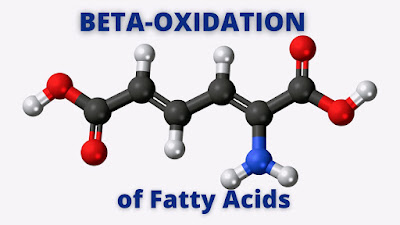Sources
Dietary lipids - Long-chain fatty acids and fat-soluble vitamins are carried to liver cells in bound form with albumin and the body triglycerides, which are used for energy production.
Site of fatty acid oxidation
It occurs in the mitochondria of all types of cells like - liver, heart, adipose tissue, kidney, lungs, skeletal muscles, and only to some extent in the brain because the brain is the chief source of medium-chain as well as short-chain fatty acid oxidation.
What are long-chain fatty acids?
Long-chain fatty acids are straight-chain fatty acids that contain twelve or more carbon atoms. Long-chain fatty acids are activated in the outer mitochondrial membrane and they are transported across the inner mitochondrial membrane and oxidation takes place inside the mitochondrial matrix.
The medium-chain, as well as short-chain fatty acids, are activated and oxidized directly in the mitochondrial matrix.
Reactions of fatty acid oxidation
- The first step is the mobilization of stored fatty acids from the adipose tissue is called lipolysis and these mobilized free fatty acids are also called triacylglycerols stored in adipose tissue and hydrolyzed to free fatty acids and glycerol with the help of hormone-sensitive lipases and the glycerol which is released during the lipolytic process is transported to the liver. Later it gets phosphorylated into glycerol-3-phosphate by glycerol kinase and is used as a substrate for gluconeogenesis.
- In step two, the free fatty acids which are released from the adipose tissue are carried in the bloodstream which is bound to serum albumin and these fatty acids are delivered to all the tissues examples like liver, heart, skeletal muscle, and kidney except for the brain as well as RBC's. So, the fatty acids dissociate from the albumin and are transported into the cells, where these fatty acids are acetylated by fatty acyl-CoA synthetase in the cytosol forming fatty acyl-coenzyme A and this fatty acyl-coenzyme A is known as activated fatty acid and the other name of the enzyme fatty acyl-CoA synthetase is thiokinase. For this reaction, this enzyme needs the cofactors like ATP, magnesium, and coenzyme A. So, this fatty acyl CoA which is formed in the cytosol is transported into the intermembrane space and the carnitine shuttle is a type of transport system which transports activated long-chain fatty acids or we can say long-chain acetylated fatty acid across the inner mitochondrial membrane to reach the mitochondrial matrix. The enzyme called carnitine acyltransferase 1 located on the outer mitochondrial membrane, where the fatty acyl-CoA reacts with the carnitine at the outer mitochondrial membrane to form fatty acylcarnitine which is the rate-limiting reaction in this pathway. This fatty acylcarnitine so formed at the outer part of the outer mitochondrial membrane is translocated into the mitochondrial matrix by carnitine acylcarnitine translocase which is the carrier protein present in the inner mitochondrial membrane and the other enzyme called carnitine acyltransferase 2 present in the inner surface of the inner mitochondrial membrane, where the fatty acylcarnitine liberates fatty acyl CoA and the carnitine. To complete the shuttle the carnitine which is cleaved in this pathway is sent back outside of the inner mitochondrial membrane by the carnitine acylcarnitine translocase and the cycle begins. so here whatever may be the fatty acyl-coenzyme A which is brought into the mitochondrial matrix for the beta-oxidation to occur now it is ready for the beta-oxidation but in turn, the medium-chain fatty acids can directly enter the mitochondrial matrix because they do not depend on the carnitine shuttle to undergo beta-oxidation.
- Now the last step is beta-oxidation, which includes beta-oxidation of fatty acids in the mitochondrial matrix. So, the oxidation system consists of four enzymes that act sequentially to yield two-carbon acetyl CoA by yielding NADH and FADH2.
- In the first step of beta-oxidation, acyl-coenzyme A is dehydrogenated by Acyl CoA dehydrogenase to produce the product called trans enoyl coenzyme A where one molecule of FAD is reduced to FADH2. So, FADH2 is formed in this reaction, in the first step of the beta-oxidation.
- In step two what happens is that the addition of the water molecule with an enzyme enoyl-CoA hydratase to trans enoyl CoA results in the production of L-beta hydroxy acyl-CoA.
- In the third step beta-hydroxy acyl-CoA is converted to beta ketoacyl CoA by an enzyme beta-hydroxy acyl-CoA dehydrogenase, where the NAD+ is reduced to NADH.
- In the last step of the beta-oxidation, where the enzyme known as beta ketoacyl-CoA thiolase splits the bond between alpha as well as beta carbon atoms of beta keto acyl-CoA as a result one acetyl-CoA and an acyl-coenzyme A with two carbon atoms less than the original acyl-CoA is produced. So, the repetition of these four reactions eventually degrades the fatty acids containing an even number of carbons finally produces acetyl CoA as the final product of the beta-oxidation.

It's very helpful want more like this
ReplyDelete